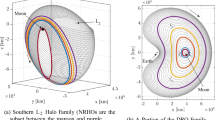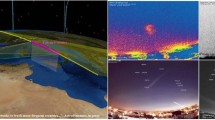Abstract
Currently, a surge in the number of spacecraft and fragments is observed, leading to more frequent breakup events in low Earth orbits (LEOs). The causes of these events are being identified, and specific triggers, such as collisions or explosions, are being examined for their importance to space traffic management. Backward propagation methods were employed to trace the origins of these types of breakup events. Simulations were conducted using the NASA standard breakup model, and satellite Hitomi’s breakup was analyzed. Kullback-Leibler (KL) divergences, Euclidean 2-norms, and Jensen-Shannon (JS) divergences were computed to deduce potential types of breakups and the associated fragmentation masses. In the simulated case, a discrepancy of 22.12 s between the estimated and actual time was noted. Additionally, the breakup of the Hitomi satellite was estimated to have occurred around UTC 1:49:26.4 on March 26, 2016. This contrasts with the epoch provided by the Joint Space Operation Center, which was estimated to be at 1:42 UTC ± 11 min. From the findings, it was suggested that the techniques introduced in the study can be effectively used to trace the origins of short-term breakup events and to deduce the types of collisions and fragmentation masses under certain conditions.

Similar content being viewed by others
References
Muciaccia, A., Facchini, L., Montaruli, M. F., Purpura, G., Colombo, C., Di Lizia, P., Bianchi, G. Observation and analysis of Cosmos 1408 fragmentation. In: Proceedings of the 73rd International Astronautical Congress, 2022.
Southworth, R. B., Hawkins, G. Statistics of meteor streams. Smithsonian Contributions to Astrophysics, 1963, 7(2): 261–285.
Lindblad, B. A. A computer search for asteroid families. Asteroids, Comets, Meteors, 1992: 363–366.
Novaković, B., Vokrouhlický, D., Spoto, F., Nesvorný, D. Asteroid families: Properties, recent advances, and future opportunities. Celestial Mechanics and Dynamical Astronomy, 2022, 134: 34.
Rożek, A., Breiter, S., Jopek, T. J. Orbital similarity functions—Application to asteroid pairs. Monthly Notices of the Royal Astronomical Society, 2011, 412(2): 987–994.
Dimare, L., Cicalò, S., Rossi, A., Alessi, E. M., Valsecchi, G. B. In-orbit fragmentation characterization and parent bodies identification by means of orbital distances. In: Proceedings of the International Orbital Debris Conference, Sugar Land, Texas, USA, 2019, 2109: 6007.
Celletti, A., Pucacco, G., Vartolomei, T. Proper elements for space debris. Celestial Mechanics and Dynamical Astronomy, 2022, 134: 11.
Celletti, A., Pucacco, G., Vartolomei, T. Reconnecting groups of space debris to their parent body through proper elements. Scientific Reports, 2021, 11: 22676.
Rossi, C., Cordelli, A., Pardini, C., Anselmo, L., Farinella, P. Modelling the space debris evolution: Two new computer codes. Advances in the Astronautical Sciences, 1995, 89: 1217.
Lewis, H. G., Swinerd, G., Williams, N., Gittins, G. DAMAGE: A dedicated GEO debris model framework. In: Proceedings of the 3rd European Conference on Space Debris, 2001, 473: 373–378.
Johnson, N. L., Krisko, P. H., Liou, J. C., Anz-Meador, P. D. NASA’s new breakup model of EVOLVE 4.0. Advances in Space Research, 2001, 28(9): 1377–1384.
Frey, S., Colombo, C. Transformation of satellite breakup distribution for probabilistic orbital collision hazard analysis. Journal of Guidance, Control, and Dynamics, 2021, 44(1): 88–105.
Alfano, S., Negron, D. Jr. Determining satellite close approaches. Journal of the Astronautical Sciences, 1993, 41(2): 217–225.
Hoots, F. R., Roehrich, R. L. Spacetrack report No. 3: Models for propagation of NORAD element sets. Department of Defense, Technical Report, 1988. Information on https://celestrak.org/NORAD/documentation/spacetrk.pdf
Vallado, D., Crawford, P. SGP4 orbit determination. In: Proceedings of the AIAA/AAS Astrodynamics Specialist Conference and Exhibit, Honolulu, Hawaii, USA, 2008: AIAA 2008-6770.
Sang, J. Z., Bennett, J. C., Smith, C. H. Estimation of ballistic coefficients of low altitude debris objects from historical two line elements. Advances in Space Research, 2013, 52(1): 117–124.
Skilling, J., Sibisi, S. Maximum Entropy and Bayesian Methods. Kluwer Academic Publishers, 1989.
Gogoi, B. B., Rajarajan, D., Kumari, A., Chandrasekhar, M. V., Nirmala, S., Kartik, A. Fragmentation analysis of a break-up event in low Earth orbit. Journal of Space Safety Engineering, 2022, 9(1): 114–123.
Flegel, S., Bennett, J., Lachut, M., Möckel, M., Smith, C. An analysis of the 2016 Hitomi breakup event. Earth, Planets and Space, 2017, 69: 51.
JAXA. Hitomi experience report: Investigation of anomalies affecting the X-ray astronomy satellite “Hitomi” (ASTRO-H). Press release, JAXA, 2016. Information on https://global.jaxa.jp/projects/sat/astroh/files/topics20160531.pdf
Information on https://www.space-track.org/ (cited 18 December 2022)
Acknowledgements
The authors are grateful to the National Key R&D Program of China (Grant No. 2022ZD0117301) for funding this study.
Author information
Authors and Affiliations
Corresponding author
Additional information
Declaration of competing interest
The authors have no competing interests to declare that are relevant to the content of this article. The author Hengnian Li is the Associate Editor of this journal and the author Yu Jiang is the Secretariat of this journal.
Yongjie Liu is an engineer of State Key Laboratory of Astronautic Dynamics, Xi’an Satellite Control Center, China. He received his master degree from the School of Mathematical Sciences, Peking University, China. His main interests are orbital mechanics and aerospace engineering. E-mail: liuyongjie_xian@163.com
Yu Jiang is a researcher of State Key Laboratory of Astronautic Dynamics, Xi’an Satellite Control Center. He received his bachelor degree from Peking University, China, and he holds his master degree, doctorate, and postdoctoral fellow of Tsinghua University, China. His main research interests include spacecraft dynamics and control, aerospace technology, space debris, dust ejecta, mega constellations, etc. He discovered the conserved quantity theorem for all equilibrium points of irregular bodies in celestial mechanics, and solved several key technical problems in Chinese aerospace engineering applications. He has published more than 60 papers and formulated 5 national standards. He won the 2021 China Space Foundation Space Contribution Award. Furthermore, in 2022, he was commended by the Central Ministries and Commissions for outstanding professional and technical talents, and he served as the leader of a top innovation team in the field of aerospace. E-mail: jiangyu_xian_china@163.com
Rights and permissions
About this article
Cite this article
Liu, Y., Jiang, Y., Li, H. et al. Determining origins of satellite breakup events in LEO region. Astrodyn 7, 465–476 (2023). https://doi.org/10.1007/s42064-023-0182-4
Received:
Accepted:
Published:
Issue Date:
DOI: https://doi.org/10.1007/s42064-023-0182-4




